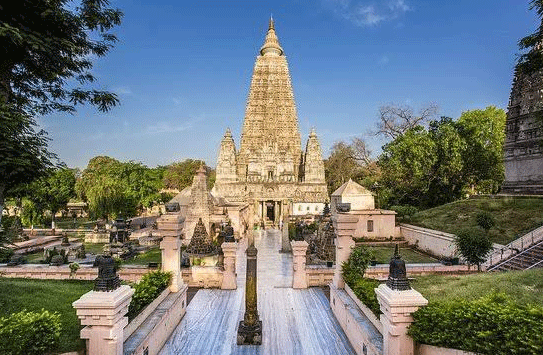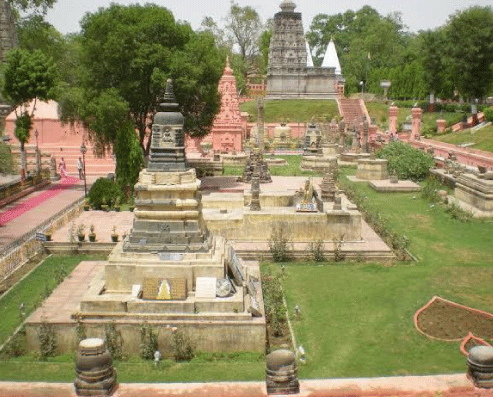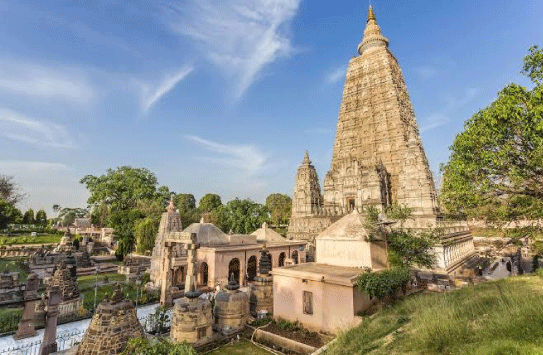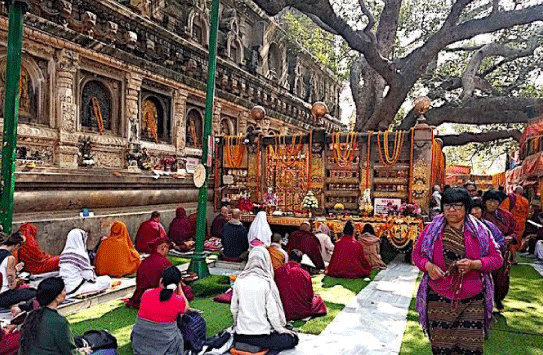Mahabodhi TempleTemples are an important part of Indian culture and tradition. It's an important place of worship not only in Hinduism but also in the other religions that originated in the land of India, such as Buddhism and Jainism. In this article, we are going to discuss one such ancient temple that is dedicated to Buddhism - The Mahabodhi Temple or the Mahabodhi Mahavihar. The literal meaning of the name of the temple is Great Awakening Temple. Though it is an ancient temple, it has been rebuilt and restored again by different dynasties. This Buddhist temple is located in Bodh Gaya, in the district of Gaya, Bihar. It is one of the most sacred places for the Buddhists as Gautam Buddha attained Enlightened at this place. This temple is also declared a UNESCO World Heritage Site due to its historical and cultural importance. The site also has a descendant of the Bodhi Tree under which Buddha attained enlightenment. 
HistoryThe temple is dedicated to the Gautam Buddha, who established the philosophy and religion of Buddhism. The original name of Gautam Buddha was Siddharth, Prince of Lumbini. He was the son of King Suddhodana and Maya Devi (who died while childbirth) and was bought up by his father. The rishis at his birth forecasted the future of the child that he would be either the greatest warrior or the greatest Shakyamuni. He chooses the ascetic life at the age of 29 after seeing an older man, a sick man, a dead body, and an ascetic sage, realizing that worldly pleasures are all meaningless illusions of the mind. He left his home in search of truth and enlightenment. After a few years of searching for the right path to attain enlightenment, he finally gained it under the Bodhi Tree in Gaya and gave his first sermon in Sarnath to his first five disciples. He was also the contemporary of the kings of Mahajanpada Magadh, an older contemporary Bimbisar, and another is Ajatshatru; both of them were from Haryanka Dynasty. Though it is a famous Buddhist pilgrimage place, even Hindus have come here for worship for over 2000 years. People visit this sacred place dating back to the period of Emperor Ashoka, but what we see now dates back to the 5th century, and some of the major restoration works were done in the 19th century. But the existing structures still incorporate a huge part of earlier work from the 2nd or 3rd century CE. The archeological pieces of evidence from the site of the temple indicate that it is an important site of veneration for Buddhists from the period of the Mauryan Empire at least. The Vajrasan, which is the Enlightenment Thrown of the Buddha within the temple, dates back to the 3rd century BCE. Numerous ancient sculptures and other elements have been moved to the museum, and many other elements of the temple, such as carved stone railing walls, were replaced by replicas. The survival of the temple's main structure is quite impressive as it was built with bricks that are covered by the stucco, and it is a lot less durable than the stone. Construction and Architecture
Though Ashoka is considered the founder of Mahabodhi Temple, the contemporary pyramidal structure of the temple dates back to the Empire of Gupta of the 5th - 6th century CE. The Hindu temples that are being constructed in the contemporary period have the same architectural design as that of the Mahabodhi Temple. However, this may be a representation of restoration work of the original construction of the 2nd - 3rd century. There are few archeological findings from Bodh Gaya's archaeological excavations, like a Kumrahar plaque from 150-200 CE has inscriptions in Kharoshthi, and the coins of Huvishka depict the temple in its current form. The truncated pyramid shape of the temple is believed to be derived from the Gandhara design of stepped stupas. The Mahabodhi Temple also has a succession of steps similar to that of design from Gandhara, and images of Buddha were sculpted in the niches alternating with Greco Roman pillars. The structure of the temple is crowned by a hemispherical stupa that is topped by finials. These designs influenced the architectural development of later Hindu temples. Today Hindu temples are characterized by the tower Shikhara with an Amalaka on the top. The temple is constructed with bricks, and surprisingly it is among the oldest brick structures that have survived in the eastern region of India. This temple itself is a fine example of Indian brickwork. The central tower of the Mahabodhi temple rises to 180ft (55 meters), and other identical smaller towers surround it. On all four sides, the temples are surrounded by railings made of stone, and they are two-meter high. The railings differ from each other in style and material used. The railings, which are older and date back to 150 BCE, are made of sandstone, while the other one is made of granite that is coarse and unpolished. The later railings are believed to be of the Gupta period. The older railing has carved scenes of the Hindu goddess of wealth Lakshmi being bathed by elephants, the other scene that has been carved on the railings is of the Hindu god Surya in a chariot drawn by four horses. In contrast, the new railings have figures of Garudas lotus and stupas. MythologyIn the complex of the temple, there is a famous lake called Mucalinda Lake. It is believed that when Buddha began to meditate under the tree (Bodhi Tree), six weeks later heavens darkened for seven days, and a prodigious rain descended. Mucalinda, the King of serpents, appeared from beneath the earth, and with his hood wide open, he protected "the one who is the source of all protection". When the storm subsided, Mucalinda assumed his human form to bow before Buddha. In Thailand and Laos, the iconography of Gautam Buddha being protected by a serpent kind while meditation is quite common. Decline
Two hundred years after the attainment of enlightenment by Buddha approx, in 250 BCE, the Mauryan Emperor Ashoka visited Bodh Gaya and established a monastery and shrine at the holy site. However, none of it could survive to date. Though the Vajrasan, which is a diamond throne that is said to be built by King Ashoka, is still worshipped today. Later the rulers of the Shunga dynasty added structures, particularly columns with pot-shaped bases near the Diamond throne. They also built the railings around the temple, and the Gupta Dynasties later extended these railings. These structures date back to the 1st century BCE. Many of the initial original railings have been dismantled and kept in Kolkata's Indian Museum. Buddhism, its tradition, and patronization by the dynasties started to decline after the invasions of Hunas. However, efforts were put by the rulers of the Pala dynasties to revive Buddhism. Mahayana sect of Buddhism flourished during the Pala Dynasty. Still, the position of Buddhism had eroded again when the rulers of the Sena dynasty defeated the Pala dynasty, and later invasions by the Turks and Arabs ruined the existing temple and vihara. The temple was restored by the Britishers and then by the state and central government of India after independence. The rulers of Burma undertook the work of construction in the 13th and 19th centuries. During the British Colonial rule in India, the work of restoration of the temple began under the direction of Joseph David Beglar and Sir Alexander Cunningham in the 1880s. Festivals
Buddha Purnima or Buddha Jayanti is one of the most important festivals for Buddhists. It is celebrated not only in India but in many Asian and Southeast Asian countries like Indonesia, Japan, Hongkong, Laos, Thailand, China, Cambodia, Bhutan, Bangladesh, Mongolia, Malaysia, Myanmar, Nepal, North Korea, Philippines, South Korea, Singapore, Sri Lanka, Taiwan, Thailand, Vietnam. It is celebrated on the date on which Gautam Buddha was born. It is one of the main festivals of the Mahabodhi Temple, which is decorated with beautiful and colorful flowers, and people pray all day long in front of the statue of Buddha and near the Bodhi Tree. In India, it is not only celebrated in Bodh Gaya but also in other Vihara that is related to Buddha. Buddha Purnima is an important festival in the Indian states of Sikkim, Arunachal Pradesh, Ladakh, Bihar, Spiti and Lahul District, Kalimpong, Kinnaur, Darjeeling, and Kurseong. In India, it was Dr. B.R Ambedkar was the one who initiated the public holiday for the festival of Buddha Purnima. Other than this, the state and central government keep organizing the Buddha Mahotsav from time to time for celebration and tourism of the temple. SignificanceIt is one of the most important places of worship in Buddhism. This is the place where Gautam Buddha attained enlightenment under the Bodhi tree; the site of the temple has a Bodhi tree and is one of the earliest surviving temples dedicated to Buddha, which gives a lot of significant information not only about the Buddha but also about the ancient history of our country. In June 2002, it became the UNESCO World Heritage Site marking its importance as philosophical and cultural history and highlighting the most important event of Prince Siddharth when he attained enlightenment and became Buddha. It is one of the holiest and most sacred places for the people of this religion. It is a pilgrimage site for Buddhists, and people from across the globe come here to worship and as a tourist as well.
Next TopicCHILKUR BALAJI TEMPLE
|
 For Videos Join Our Youtube Channel: Join Now
For Videos Join Our Youtube Channel: Join Now
Feedback
- Send your Feedback to [email protected]
Help Others, Please Share










